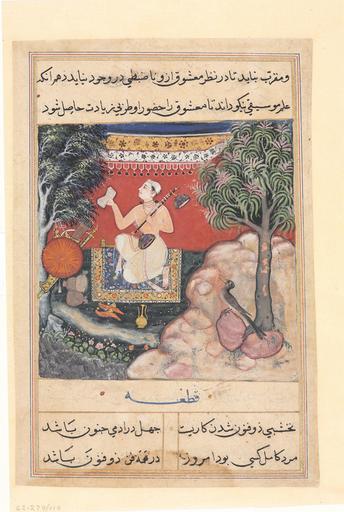MAKE A MEME
View Large Image

| View Original: | The_Origin_of_Music_Page_from_a_tutinama_Manuscript.jpg (1342x2000) | |||
| Download: | Original | Medium | Small | Thumb |
| Courtesy of: | commons.wikimedia.org | More Like This | ||
| Keywords: The Origin of Music Page from a tutinama Manuscript.jpg The Iranian legend of the mythical bird the Mausiqar which provides the seven notes that are said to comprise the origin of music is the inspiration for this composition The bird that serves as the musician ™s muse almost goes unnoticed while attention focuses on the vina player seated on a beautiful rug This work aspires to invoke aesthetic pleasure rasa and music is deemed a means to stimulate love What enchantment was hidden in last night ™s potion I lost my head but it was not a drunken sensation The reworking of this painting recently has been attributed by John Seyller to the young Basawan the Iranian painter recruited to Akbar ™s atelier who became Akbar ™s personal favorite Basawan ™s participation in this project was first identified by Pramod Chandra in 1976 That the Tutinama was Mughalized during the period the Hamzanama was in production is witnessed by the treatment of such signature motifs as the shield sword and bow as well as the quiver hung on a tree a device directly repeated in a number of Hamzanama paintings About the Artist Basawan Active ca 1556 “1600 at the Mughal court; father of Manohar Basawan joined Akbar ™s atelier at Delhi as a young Hindu recruit and was involved in every major manuscript production throughout his emperor ™s reign Abu ™l Fazl recorded that Basawan surpassed all in composition drawing of features distribution of colors and portrait painting and was even preferred by some to the first master of the age Daswanth The mature Akbar prized Basawan above all others for his gift of faithful representation and also for advancing the Mughal style He was a pioneer in responding to and absorbing new pictorial devices from European art; naturalistic portraiture atmospheric perspective and a painterly approach to landscape are his hallmarks Basawan was already an accomplished painter in the early 1560s when he participated in the Mughal reworking of the Tutinama manuscript The Origin of Music demonstrates his talent for portraiture and his ability to render rocks and trees with a naturalism not seen before in subcontinental painting In addition Basawan was a key contributor to the monumental Hamzanama series as a painter of portraits rocks and trees and also as a master of composition In the folio that portrays a night attack on the camp of Malik Iraj Basawan ™s hand is visible in the rock formations and the densely foliated trees as a comparison with those motifs in his Khamsa of Amir Khusrow Dihlavi page clearly demonstrates The composition of this Hamzanama folio has an underlying similarity to an ascribed work by Basawan in the Victoria and Albert ™s Akbarnama that shows Akbar witnessing the armed combat of Hindu ascetics made some twenty years later Basawan ™s most lasting legacy is the response to European art that he brought to Mughal painting His ability to grasp the pictorial possibilities of both atmospheric and linear perspective was unmatched His paintings of the later 1590s are a revolutionary fusion of these European pictorial devices into a newly emerging post-Safavid Mughal style The vain dervish from an imperial copy of the Baharistan dated 1595 displays Basawan ™s gift for theatricality combined with an astonishing ability to capture naturalistic detail as witnessed in every aspect of this masterpiece from the figures in conversation to the goats and peacocks that inhabit the setting Basawan routinely used his signature rocks and trees to create receding intercepting spaces in the European mode Like all imperial painters of his time he had access at the court to northern European engravings of Christian subjects and cameo-type portraits and he drew freely on that imagery Basawan typically placed his European-inspired figures in a visionary Mughal setting with fantastic rock formations of Iranian derivation ca 1565 “70 http //www metmuseum org/Collections/search-the-collections/60050334 rpp 20 pg 1 ft akbar pos 8 Attributed to Basawan Indian active ca 1556 “1600 PD-Art Uploaded with UploadWizard Tutinama | ||||